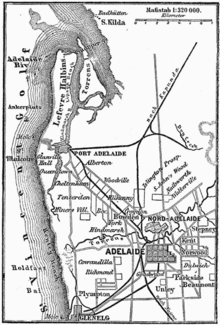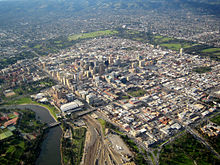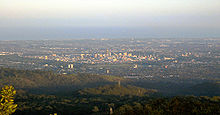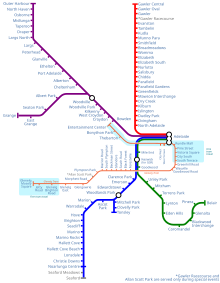Adelaide
| Adelaide | |||||||
|---|---|---|---|---|---|---|---|
 North Terrace in Adelaide |
|||||||
|
|||||||
|
|||||||
|
|||||||
|
|||||||
|
|||||||
|
|||||||
|
|
|||||||
Adelaide [ ˈædəleɪd ] is the capital of the state of South Australia in Australia . Adelaide is a coastal city on the Saint Vincent Gulf and was named by the first governor of the state, Captain John Hindmarsh (1785-1860), in 1837 after the British Queen Adelaide ( Adelheid von Sachsen-Meiningen ). In contrast to cities like Sydney or Hobart, Adelaide did not emerge from a convict colony.
The city is nicknamed "festival city" because of its cultural events, such as the Glenelg Jazz Festival or the Adelaide Festival of Arts. Adelaide is also called the “city of churches”. Adelaide has hosted several sporting events, including As of 1985 bis 1995 the Australian Grand Prix of Formula 1 at the Adelaide Street Circuit .
The city of Adelaide actually only consists of the city center within the park ring, divided into Adelaide and North Adelaide. It has 22,000 inhabitants. However, the directly surrounding 250 places are added to the urban area.
In a ranking of cities according to their quality of life, Adelaide was ranked 29th out of 231 cities worldwide in 2018.
geography
Geographical location
Adelaide is north of the Fleurieu Peninsula , between the Gulf Saint Vincent and the Mount Lofty Mountains . The city extends 20 km from the coast to the foothills of the mountains. According to the Australian Bureau of Statistics , the metropolitan area of Adelaide has a total area of 870 km² and an average height of 50 m . At 727 meters, Mount Lofty is the highest point in the metropolitan area.
Before the settlement of this area, Adelaide was mostly covered by bushland. The coastal areas were predominantly swamps and bogs. Several rivers and streams flow through the metropolitan region. The largest catchment areas are the River Torrens and Onkaparinga River . The city's basic water supply is provided by the Happy Valley Reservoir with a share of 40% and the larger Mount Bold Reservoir with 10% .
City structure
The metropolitan area of Adelaide is divided into 19 Local Government Areas (LGAs):
climate
Adelaide has a Mediterranean climate with hot, dry summers and cool winters. The average temperature between December and February is around 28 ° C, but can climb to over 40 ° C. In winter, mainly in July and August, they usually range between 5 ° C and 15 ° C. The climate is arid from November to mid -April and humid from mid-April to October . A common name of the city is "The dryest city in the dryest state of the dryest country of the dryest continent of the world" (German: The driest city in the driest state of the driest country of the driest continent in the world).
| Adelaide Airport | ||||||||||||||||||||||||||||||||||||||||||||||||
|---|---|---|---|---|---|---|---|---|---|---|---|---|---|---|---|---|---|---|---|---|---|---|---|---|---|---|---|---|---|---|---|---|---|---|---|---|---|---|---|---|---|---|---|---|---|---|---|---|
| Climate diagram | ||||||||||||||||||||||||||||||||||||||||||||||||
| ||||||||||||||||||||||||||||||||||||||||||||||||
|
Average monthly temperatures and rainfall for Adelaide Airport
Source: Australian Bureau of Meteorology : Adelaide Airport Station. Observation period: 1955–2013 (hours of sunshine 1983–2013). Retrieved December 27, 2013.
|
|||||||||||||||||||||||||||||||||||||||||||||||||||||||||||||||||||||||||||||||||||||||||||||||||||||||||||||||||||||||||||||||||||||||
history
Before the settlement by Europeans, around 300 Aborigines of the Kaurna tribe lived in what is now Adelaide . Those who survived the introduced diseases were later resettled in the Port Lincoln area , well outside of their ancestral territory.
In 1627 the Dutchman Pieter Nuyts mapped the coast of South Australia, and in 1802 these coasts were explored, but then by the British. William Light , Surveyor-General of South Australia, planned the city and designated a site about ten kilometers inland on the River Torrens for the construction of the capital of the new colony. The wide, checkerboard-patterned streets and the spacious parks are also thanks to him. Governor John Hindmarsh named the city, founded in 1836, on instructions from the British royal family after Queen Adelaide , the German Princess Adelheid von Sachsen-Meiningen (1792–1849) and wife of the British King Wilhelm IV , who came from Meiningen .
In November 1838 the colony promised the settlers freedom of religion . The majority of the early settlers were Protestant British such as Baptists , Presbyterians and Methodists , who had suffered reprisals in their homeland due to the nonconformity of their beliefs with that of the Anglican Church . In 1839 the first Old Lutherans came to Adelaide from Prussia , who had experienced repression in their homeland and were given by King Friedrich Wilhelm III. had been persecuted for resisting the forced union with the Reformed (Calvinists).
Also in 1839, the Adelaide Chamber of Commerce was established and land outside the city center was made available for growing food.
Significant silver and copper finds in the early 1840s, and later lead finds, caused the first economic boom. Australia quickly became one of the British Empire's largest metal exporters . Around 30 “suburbs” such as Unley and Norwood developed quickly outside the Adelaide ring road. As early as 1851, the number of European settlers was around 14,600.
In 1856, Port Adelaide was connected to Adelaide by a steam-powered railway. A large water supply was installed in 1861 and the gas supply in 1863. In 1872 Adelaide was the first Australian city to be connected to London by telegraph . In 1878 the expansion of the tram began, then pulled by horses to connect several parts of the city. In 1901 a power plant was built to supply the residents.
Another economic boom between 1870 and 1890, this time due to wheat, triggered another construction boom. Many of the buildings that were built during this period shape the face of the city today.
In the 20th century, much of the immigrants were still mainly British. After the end of the Second World War , many Italians and Greeks joined them. In the 1970s, many Vietnamese and Latin Americans immigrated . In addition to immigrants from many other countries around the world, they shaped the image of the city and the way of life.
Adelaide's image as a city of culture has its origins in the 1970s. Prime Minister Don Dunstan promoted the Adelaide Festival of Arts, as well as legislation in South Australia.
The area enclosed by the park ring is now mainly a business district.
Culture and sights
- The Parkring: The old city center, today a financial and business district, is lined with a parking ring up to 600 m wide, which is divided into 27 individual parking areas with different equipment such as toilets, various sports fields, fixed barbecue areas, hiking trails, bike paths and other leisure facilities. The area is about 4 × 5 km² in total. During the founding period, the ring served as a rampart. At that time, common guns , e.g. B. cannons , can be fired a maximum of 600 m; crossing the plant z. B. with foot soldiers was made more difficult by dense, intensive forest cover.
- Adelaide Festival Center: The Adelaide Festival Center is a complex consisting of several theaters and exhibition rooms. There are theater performances of all kinds, modern art exhibitions, dance performances, operas, musicals and cabaret.
- Art Gallery of South Australia : In particular, works by native painters from the 19th century and European art from 1500 to the present day are exhibited here.
- South Australian Museum : The museum has a large collection of Aboriginal objects and the "Egyptian Room". In addition, there is a Discovery Center on the 2nd floor and in the Flinders Ranges ( Ediacaran found), probably the oldest fossils of the earth's history on the 3rd floor.
- The Migration Museum presents the personal history of several immigrants, their belongings, as well as models and parts of the immigrant ships.
- Botanic Gardens : opened in 1857; with the Palm House , a Victorian-style greenhouse imported from Bremen in 1875 and opened in 1877.
- Zoological Gardens: Almost in downtown Adelaide. Particular emphasis is placed on the breeding of seldom occurring animal species, both domestic and other.
- Warrawong Sanctuary: 14 acres of restored Australian bush and re-introduced animals from the Adelaide Hills are found. Particular attention is paid here to endangered native species.
- Cleland Wildlife Park: Within the Cleland Conservation Area in the Adelaide Hills , this park was established and contains native fauna.
- Mt. Lofty Lookout: Highest mountain at 710 m above sea level. NN the Mt. Lofty Ranges with views over Adelaide to the sea.
- Glenelg and Glenelg Historic Tram: Glenelg, a district of Adelaide, is right on the ocean. The jetty, a long boat launch, is one of the attractions. From the city center there is a tram that runs regularly between Victoria Square and Glenelg.
- Shark Museum: In Glenelg, near the tram terminus, is the Shark Museum of Rodney Fox, who survived an attack by one of the great white sharks that lived off Adelaide.
Attractions in the Adelaide area include Barossa Valley , McLaren Vale, Hahndorf and Kangaroo Island .
traffic
Airport
The Adelaide airport is West Beach and is about eight kilometers from the city center. Adelaide Airport is Australia's fifth busiest airport, with both domestic and international flights arriving.
Long-distance rail transport
A train station just outside the city center (Keswick Terminal) has direct connections to Melbourne , Perth , Sydney , Darwin and Alice Springs . These connections are mainly used for freight traffic, but special trains for passenger traffic such as " The Ghan ", "The Indian-Pacific" and The Overland operate .
Transportation
All modes of public transport are organized by the state company Adelaide Metro (funded by the government of South Australia) :
- Rail: There are six inner-city lines that meet centrally at the Central Station on North Terrace. The entire lines are served exclusively by diesel railcars, as the lines are not electrified.
- Tram: Adelaide had an extensive tram network until 1958 , but only one line survived the wave of closings in the 1950s. This line runs largely on its own track from the city center to Glenelg, a suburb on the coast. The longest articulated tram cars in the world were used in Adelaide (type "H", 17.20 m). These vehicles have now been replaced by Bombardier Flexity Classic trains. The old trams are only occasionally used on Sundays and public holidays.
- Buses: A bus network completes Adelaide's public transport system. There are around 7,400 stops and a total of 1,150 kilometers of bus routes in the city. Adelaide also has the twelve kilometer long Adelaide O-Bahn , a track bus system from the 1980s. Stops are only marked with numbers and there are no timetables at many stops, as well as information on the lines running at the stop and the direction of travel. In addition to single and multiple tickets with ten journeys, there is also a season ticket that is valid for 28 days (28 day pass). There is a “Free Connector Bus” in the city, which goes to the most important stations in the city. This bus is partly one of the first fully solar-powered buses.
Cycles
An offer of the "Adelaide City Council", so the city administration, are freely available bicycles (including mandatory helmet) at some places, z. B. hostels or bike shops. A form must be filled out and an ID card, e.g. B. be left a driver's license.
In 2014, the city of Adelaide hosted the international Velo-city bicycle traffic congress.
Ferries
There are no longer any ferries that operate regularly from the Adelaide metropolitan area. There are regular ferry services to Kangaroo Island from Cape Jervis or Wirrina (about 100 km south of Adelaide).
economy
Much of the Australian defense industry is located in the greater Adelaide area. The Australian subsidiary of BAE Systems (second largest defense company in the world), BAE Systems Australia, and the Australian subsidiary of Lockheed Martin have their main locations in Edinburgh Parks northwest of Adelaide. The Technology Park Adelaide (the first of its kind in Australia) in Salisbury City (north of Adelaide) houses the defense and aerospace divisions of Saab and Raytheon , as well as other global high-tech companies such as Topcon , Optus and Xtralis . The state-owned Australian Submarine Corporation has its headquarters in the suburb of Osborne .
The largest Australian oil and gas exploration company, Santos , the largest Australian brewery Coopers Brewery, the investment company Argo Investments and one of the largest Australian trading companies Harris Scarfe are all headquartered in Adelaide.
One of the world's largest media conglomerates, the News Corporation , was founded in 1979 by Rupert Murdoch in Adelaide and had its global headquarters there until 2004.
General Motors ' Australian car brand , Holden , had one of its two plants in the Elizabeth suburb until 2017.
The Adelaide Casino is located in the former train station building in the north of the city center . With over 1000 employees, the casino is the tenth largest employer in the city.
Universities
- Flinders University (Flinders)
- University of Adelaide (Adelaide)
- University of South Australia (UniSA)
Town twinning
Sister cities of Adelaide are:
-
 Christchurch , Canterbury Region , New Zealand , since 1972
Christchurch , Canterbury Region , New Zealand , since 1972 -
 George Town , Penang , Malaysia , since 1973
George Town , Penang , Malaysia , since 1973 -
 Himeji , Hyogo Prefecture , Japan , since 1982
Himeji , Hyogo Prefecture , Japan , since 1982 -
 Austin , Texas , USA , since 1983
Austin , Texas , USA , since 1983
We have also had friendly relations with three Chinese cities since 2001 :
sons and daughters of the town
- Samuel Adamson (born 1969), playwright and screenwriter
- Jai Angsuthasawit (* 1995), Australian-Thai cyclist
- W. Ross Adey (1922-2004), neuroscientist
- Paul Agostino (* 1975), Australian-Italian soccer player
- John Aloisi (* 1976), football player
- Judith Anderson (1897–1992), actress
- Wayne Arthurs (born 1971), tennis player
- Fabian Barbiero (* 1984), football player
- Norman Rupert Barrett (1903-1979), surgeon
- Sir William Lawrence Bragg (1890–1971), 1915 Nobel Laureate in Physics
- Jack Brokensha , jazz musician (vibraphone, drums) (1926–2010), arranger and composer
- Loene Carmen (* 1970), musician and actress
- Nathan Coenen (born 1992), actor
- Tiffany Cromwell (* 1988), cyclist
- Sarah Crowley (* 1983), duathlete and triathlete
- Rohan Dennis (* 1990), track and road cyclist
- Travis Gareth Dodd (born 1980), football player
- Annette Edmondson (* 1991), racing cyclist
- Alexander John Gosse Downer (born 1951), politician
- Lord Howard Walter Florey (1898–1968), medic (1945 Nobel Prize winner for medicine)
- Henry Frayne (* 1990), three and long jumper
- Sia Furler (* 1975), singer
- Amy Gillett (1976-2005), rower and racing cyclist
- Matthew Glaetzer (* 1992), track cyclist
- Aaron Goulding (* 1982), football player
- Joshua Harrison (* 1995), cyclist
- Lleyton Hewitt (* 1981), professional tennis player
- Damien Howson (* 1992), racing cyclist
- Rosealee Hubbard (* 1980), track cyclist
- Margaret Illmann (* 1965), prima ballerina
- Leo Joseph (* 1958), ornithologist
- Jordan Kerr (born 1979), tennis player
- Sir Sidney Kidman (1857-1935), cattle baron
- Alexander John Kosmina (* 1956), football player and coach
- Joanna Lewis (* 1963), violinist and composer
- Lionel Logue (1880–1953), speech therapist
- Stefania Łukowicz-Mokwa (1892–1975), Polish musician
- Osama Malik (* 1990), soccer player
- Michael Robert Marrone (* 1987), football player
- Steve Martin (* 1968), motorcycle racer
- Brian May (1934–1997), film music composer
- Ryan McGowan (born 1989), football player
- Keith Michell (1926-2015), actor
- Alicia Molik (* 1981), tennis player
- Francesco Monterosso (* 1991), football player
- Stephanie Morton (* 1990), track cyclist
- Daniel Mullen (* 1989), football player
- Matthew Mullen (born 1989), football player
- James Obst (* 1990), poker player
- Stuart O'Grady (* 1973), racing cyclist
- Geoff Ogilvy (* 1977), professional golfer
- Sir Mark Oliphant (1901–2000), physicist and Governor of South Australia
- Orianthi (* 1985), musician (lead guitarist of Michael Jackson)
- Teresa Palmer (* 1986), actress
- Alexander Porter (* 1996), cyclist
- David Pullan (born 1962), actor
- Scott Pye (* 1990), racing driver
- Anna Rawson (* 1981), golfer
- Roy Rene (1891–1954), comedian and actor
- Luke Roberts (* 1977), racing cyclist
- Uwe Schummer (* 1957), German politician
- Adam Scott (born 1980), professional golfer
- Emily Seebohm (* 1992), swimmer
- David Solari (* 1968), Australian-Italian racing cyclist
- Robert Stigwood (1934–2016), music and film producer
- Corey Sweet (born 1976), racing cyclist
- Terence Tao (* 1975), mathematician
- Andrew SW Thomas (* 1951), US astronaut at NASA
- Alex Tobin (* 1965), soccer player
- Sonia Todd (born 1959), actress
- James Troisi (* 1988), football player
- Aurelio Vidmar (* 1967), football player and coach
- Anthony "Tony" Vidmar (* 1970), football player
- John Robin Warren (* 1937), pathologist (2005 Nobel Prize winner in medicine)
- Michael White (1948-2008), psychotherapist
- Martin Wesley-Smith (1945–2019), composer
- Rohan Wight (* 1991), cyclist
- Mark Woodforde (born 1965), tennis player
- Max Worthley (1913–1999), Australian singer (tenor) and vocal teacher
Others
On November 30, 1948, a mysterious, never-before-seen man ( Somerton Man ) appeared on Somerton Beach . He died of an unknown poison on the morning of December 1, 1948. Neither the origin nor the identity of the man could ever be clarified. To date, the investigation into the case has not been completed.
There are free W-LAN hotspots with the SSID "Internode" in the city. They are often located near or in public buildings, e.g. B. Libraries.
literature
- Friedrich Christmann: The New Book of Travel and Discoveries: Australia . Otto Spamer: Leipzig 1870, pp. 117–127
- John Mac Douall Stuart: Diary of Explorations from Adelaide, South Australia, Across the Continent of Australia, December, 1861, to December, 1862. 1862
Web links
Individual evidence
- ^ Australian Bureau of Statistics : Adelaide ( English ) In: 2016 Census QuickStats . June 27, 2017. Retrieved April 8, 2020.
- ^ Australian Bureau of Statistics : Adelaide ( English ) In: 2016 Census QuickStats . June 27, 2017. Retrieved April 8, 2020.
- ^ Australian Bureau of Statistics : North Adelaide ( English ) In: 2016 Census QuickStats . June 27, 2017. Retrieved April 8, 2020.
- ↑ Mercer's 2018 Quality of Living Rankings. Retrieved July 30, 2018 .
- ↑ Cf. Matthias Blazek: Adelheid von Sachsen-Meiningen / namesake of Adelheidsdorf and Adelaide - later Queen of England remains childless and has probably never been in the Celle area. Sachsenspiegel 45, Cellesche Zeitung of November 10, 2012.
- ↑ www.history.sa.gov.au. ( Memento from February 20, 2007 in the Internet Archive )
- ↑ On December 8, 1963, Rodney Fox was bitten in the side by a 3.5 m long great white shark during the Australian diving championships. (Döll, Alexandra: “Shark attacks - viewed with a sense of proportion”, suite101.de).
- ↑ Archive link ( Memento from August 6, 2016 in the Internet Archive )
- ↑ About us. Adelaide Casino, accessed March 10, 2018 .
- ↑ a b Adelaide City Council: Sister Cities ( Memento of May 11, 2015 in the Internet Archive ), accessed on March 13, 2014.
- ↑ Internode's wireless hotspots .






